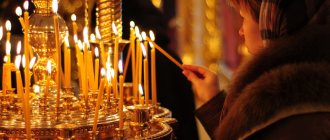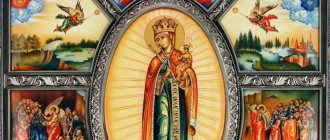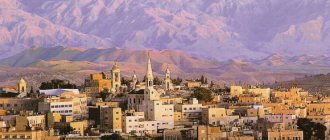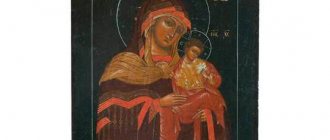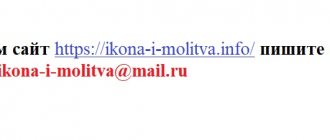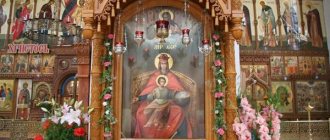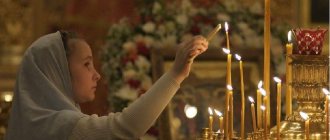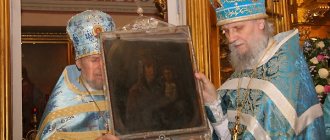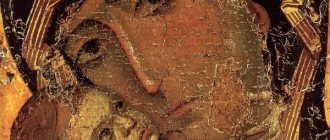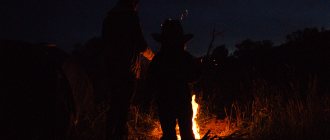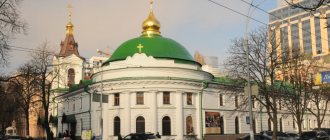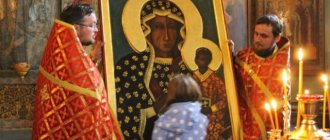Every believer comes to church to talk to God and ask about what worries and interferes with a peaceful life. In Orthodoxy, it is customary to depict biblical scenes and holy images on icons. The Icon of the Mother of God “The Joy of All Angels” is not known to all parishioners and is not found in every cathedral. Every believer should become familiar with the semantic meaning of the sacred image and the prayers that can be read.
“The Joy of All Angels” was received as a gift by Patriarch Kirill after the consecration of the Resurrection Cathedral. The icon is part of the main iconostasis of the New Jerusalem Resurrection Church at the monastery in the city of Istra, Moscow region.
What to pray for to the Unexpected Joy icon
A prayer service before the divine image helps:
- Helps to gain inner spiritual strength and mental balance;
- Thanks to prayer, you can get everything that you have dreamed of for so long, but no longer hoped to receive, someone forgiveness, repentance or salvation of a sinful soul;
- The prayer service also helps in curing illnesses, especially hearing loss;
- Our Lady will help people who have lost their loved ones to find them and return them to their loving relatives;
- Pregnant women will be helped to bear a child and give birth to him healthy;
- For parents whose children have gotten out of hand and have also taken an immoral path, the image will help bring them to their senses and guide them on the right path;
- Resolves disputes, resolves conflicts, and seemingly failures can all turn out to a happy ending.
What to pray to the holy image for
The Mother of God is traditionally prayed for:
- calmness and intercession in trouble;
- peace (it is no coincidence that the first solemn service before the newly painted icon was a prayer for an end to strife in Ukraine);
- health of loved ones;
- diverting harm from those who are defenseless against threat, from infants and the elderly.
Mothers and brides should trust in the intercession of the Mother of God in relation to loved ones who are in danger.
More about prayers to the Mother of God:
At one of the most famous religious processions of the Stalin era, on the frosty days of December 1941, images of the Tikhvin Mother of God were carried, and the miraculous face of the Kazan Mother of God was carried through the trenches at the front. The people firmly established the legend of the “air crusade”, that the city was saved, as in the Time of Troubles, by the Don Mother of God, with whose icon they flew around the capital on an airplane.
Already in the 17th-19th centuries, it became a custom to ask the Mother of God for help in various women’s matters: when they fail to get pregnant, they pray to her for the preservation of the fetus in the womb, but the Mother of God always responds to prayers for the health of babies. She is considered the wise patroness and intercessor of all mothers.
They also pray before the Holy Mother of God for:
- guidance on the righteous path;
- getting rid of illnesses (mental and physical);
- moral strength and strengthening in the Holy Orthodox Faith.
Important! It is understandable that neophytes or Orthodox people who are not strong in their faith want to test various icons for their “power of help.” In fact, it is important to remember that it is not this or that image of the Virgin Mary that helps, but the Virgin Mary herself
And whether your requests will reach her does not depend on how “beautifully drawn” or “fashionable” any of Her images are: the fulfillment of prayer aspirations depends on the strength of the Christian’s faith and his sincerity.
From the point of view of Christian dogma, it makes no difference whether you bow with requests before the most ancient icon, before the image of the “Joy of all Angels,” or before the newest (but at the same time consecrated!) icon. The Virgin Mary, the Mother of God of joy, is precisely known for being the most lenient and responsive to any requests, except those that contain sinful desires.
Description of the icon
One of the most famous icons of the Mother of God today is the icon of the Mother of God “The Joy of All Angels” of the New Jerusalem Monastery. She is neither the most ancient nor associated with historical legends about the intercession of the Virgin Mary, like the images of the Don or Tikhvin Mother of God. Nevertheless, it is most popular among Orthodox Christians today.
Icon of the Mother of God “The Joy of All Angels”
This is one of the most famous “newly painted” (that is, painted relatively recently) icons. The exact date of painting is unknown, but this image was drawn from a Smolensk icon brought by the wife of Donskoy’s son, Vasily Dmitrievich, the famous “Litvinka” Sophia (not to be confused with Sophia Palaeologus), daughter of Vytautas ─ “The Gracious Sky”.
Art historians believe that before this image, the Mother of God was painted either sitting with a baby (as in Rublev’s “Trinity”), or in the Byzantine tradition of “digitria”, where the Virgin Mary can stand, but Christ becomes the central figure of the composition (Our Lady of Kazan). On the “Joy of all Angels”, as well as on the “Gracious Sky”, the Mother of God stands in all the glory of her holiness and the gaze is drawn primarily to her.
As in most icons, the Mother of God is depicted in purple and a blue tunic. But the New Jerusalem “Joy of All Angels” has unique, characteristic details only for this image:
- apocalyptic motifs (Mary is depicted trampling under her feet the moon in the form of an inverted crescent, which is not at all an allusion to the symbol of Scripture, but an illustration of the words of St. John: “and the moon will be under her feet”);
- a recognizable and realistic image of the New Jerusalem Monastery (the towers of its Resurrection Cathedral from below almost reach the moon).
An interesting fact: on the “primary” icon, “Blessed Sky”, the Holy Mother of God tramples... the sun!
This is less consistent with Scripture. “The Joy of All Angels” is one of the rarest icons with the addition of a recognizable realistic landscape. Even more attention to the icon was attracted by its donation to the Patriarch from the New Jerusalem Monastery at a solemn service on the occasion of the completion of all restoration work in the spring of 2021.
How does the Joy of All Angels icon help?
It is believed that a petition to any icon requires a certain prayer. However, prayers are addressed to the saints themselves, depicted in the images; the icon only conveys the image of the saint. If faith is strong and thoughts are pure, then the request will be heard.
The strength of faith, love and sincerity in the heart will help to cope with the misfortune that befalls a person.
The Holy Intercessor is also asked for the healing of women’s ailments, for assistance in childbirth and pregnancy, and for the gift of a child. The Blessed Virgin Mary is revered as the Patroness of Motherhood. But this does not mean that you cannot ask the Blessed Virgin for help in family matters or to increase your mind. Holy prayers will be heard if there is no sinful intention or desire in them.
There are many icons dedicated to various images of the Mother of God. Like the icon “The Joy of All Angels”.
Despite the fact that there are no special prayers read in front of this icon, you can turn to the intercession and help of the Mother of God with any prayer addressed to Her.
The Legend of the Hand of Saint John of Damascus
Why did a third hand appear on the icon? According to church tradition, the first such image appeared in the 8th century in the Syrian city of Damascus. A silver medallion in the shape of a brush was attached to an ordinary icon of the Mother of God by Saint John of Damascus in gratitude for healing his hand. Saint John lived during the reign of the Byzantine Emperor Leo, who forbade the worship of images of Jesus Christ, the Virgin Mary and saints in his state. John of Damascus, being an influential official of the Arab Caliphate neighboring Byzantium, on the contrary, actively defended the ancient custom of venerating icons among Christians.
Unable to directly deal with his enemy, the emperor slandered John of Damascus before the caliph, accusing him of preparing a rebellion against Muslim rule in Damascus. This contradicted the peace treaty between Byzantium and the caliphate, and the caliph, enraged, ordered John of Damascus’s hand to be immediately cut off. When the caliph's anger passed, and no evidence of political treason was found, John asked the Muslim ruler to return his severed hand. The slandered man took his hand to his room and prayed all night at the icon of the Virgin Mary. Waking up in the morning, John of Damascus discovered that the severed hand had grown back and was completely healthy. In gratitude for this unprecedented miracle, the saint attached a medallion in the form of a hand at the bottom of the icon.
The list of the “Three-Handed Lady” from the New Jerusalem Monastery, which became the model for many other lists of this icon in Russia, does not entirely correspond to the church legend. Looking at the version of the icon given to Nikon, one gets the impression that the extra hand belongs specifically to the Mother of God, and does not symbolize the severed hand of St. John of Damascus. For some reason, the painter depicted a hand in the same clothes in which the Mother of God is dressed. In this regard, later a new interpretation appeared in the New Jerusalem Monastery, according to which the hand appeared on the icon itself during the work of the icon painter. Thinking it was someone's joke, the artist first tried to paint it over, but over the course of several days the extra hand appeared again and again on the board. Finally, the monk heard a voice in a dream, explaining to him that the Virgin Mary was holding the baby Jesus with two hands, and with the third hand she was holding her veil over the people who worshiped her.
In 2011, on the eve of the 350th anniversary of the appearance of the “Three Hands” in the New Jerusalem monastery, another copy from an authentic icon of the Serbian Hilandar monastery was brought from Athos. The new list can be seen to the right of the entrance at the beginning of the bypass gallery of the Resurrection Cathedral. This version of the icon, which much more accurately corresponds to the original Athos image, is noticeably different from Nikon’s. In addition to the strict “eastern” facial features of the Virgin Mary herself, the third hand is not drawn here, but is depicted in the form of a silver overlay, which is why the hand of St. John cannot in any way be confused with the hands of the Virgin Mary herself.
The meaning of the icon “Joy of All Angels”
The Icon of the Mother of God "Joy of All Angels" is a recently created Orthodox image. The basis for the creation of the sacred scripture was the icon of the Most Holy Theotokos “Blessed Heaven”, located in the Archangel Cathedral of the Moscow Kremlin.
The icon depicts the Blessed Virgin Mary in full growth with the baby Jesus in her arms. Angels flutter around Her. The Mother of God stands on the month, which reads “And the moon is under her feet,” and above Her head angels hold a golden crown. The Child Christ holds in his hands a golden orb (round ball), decorated with jewels and crowned with a cross. This symbol represents royal power.
The phrase “And the Moon is under her feet” is part of the Scripture about the end of the world, which commemorates the image of the Blessed Virgin Mary in the rays of the sun, standing on a crescent moon and surrounded by stars. At the bottom of the icon is the New Jerusalem Resurrection Monastery. It turns out that the Virgin Mary hovers in the air above the cathedral, illuminating the holy place. This feature distinguishes the icon from its prototype, “The Gracious Sky.”
The crescent moon in the church sense signifies revelations about the End of the World. The crescent is also used on crosses placed on church domes.
The direct meaning of the icon of the Mother of God “The Joy of All Angels” refers to the prophetic end of the world and says that not everyone will be able to get into the Kingdom of God.
How does the Unexpected Joy icon help and its meaning?
Since some of the first icons, created in the 18th century, appeared, their miraculous properties began to spread. With the help of the image of the Queen of Heaven, various healings of weak and sick people took place, and one could protect oneself from all sorts of misfortunes by turning to the Mother of God in prayer.
The meaning of the icon Unexpected Joy
All human life consists of small joys that are not always noticed by people and, in pursuit of an illusory dream, they forget to pay attention to their loved ones and express words of gratitude to them. This is precisely why cherished dreams are not fulfilled, since they become an obsession, and this is precisely what does not give a person the opportunity to rejoice in a new day
Unexpected joy, the meaning and essence of her face carries hope in God’s will, as well as renunciation of immoral deeds and sinful thoughts. Gratitude should come from every day spent in peace and warmth. Repentance for bad thoughts and criminal acts, bitterness, envy and anger, which quite often overwhelm human hearts.
We advise you to study Is it possible for Orthodox Christians to swim in the Dead Sea?
It’s not so hard to just come up and pray to the Holy Face; spiritual work, and daily work at that, will be much more difficult. When you need to learn to pacify your envy and pride, not to be rude, and also to know when it is better to remain silent, teach yourself calmness and self-control, but also not forget about a friendly attitude, both towards relatives and strangers.
People by their nature are prone to weakness and sin, and if you humbly come to terms with this and call for the help of the Intercessor, then even the most fallen of people can get a chance to be forgiven.
The divine image personifies the whole essence of spiritual transformation. Hard work on oneself and said prayers will allow a person to choose the right path, the path of goodness and love.
Brothers and sisters in Christ. We run our own community on VKontakte https://vk.com/molitvuikonu called Prayers for Every Day, where we try to post Orthodox prayers and news. If you have your own VK page, subscribe to us.
Description and meaning in Orthodoxy
The icon depicts the Virgin Mary with the baby Jesus sitting on her lap. In his hand is a small white flower - a symbol of purity and sinlessness. The Virgin Mary is covered in rich clothing with lush folds. The holy family looks happy and spiritual. Next to the Mother and Son on the icon there are two saints who accepted martyrdom: on the right side of the Virgin Mary is the elder Joseph the Betrothed, on the left is the young man John the Baptist. Both saints look at the infant Christ with love, joy and reverence.
The images of saints on the icon are painted alive, with noticeable emotions on their faces, which is more typical for Orthodox than for Catholic iconography. Among Catholics, the saints on a similar icon are depicted as calmer and more restrained. Even in Catholic iconography, it is customary to paint a white lamb next to the Virgin Mary - a symbol of sacrifice, and the Baptist is depicted not only in youth, but also in adulthood. Elder Joseph is not on the Catholic version of the image; he is present only on the Orthodox icon.
In Orthodoxy, the icon of the “Three Joys” has two meanings - worldly and high. The face of the Holy Virgin is depicted with an expression of great happiness and peace, because she became the mother of the Savior of the human race - this is the joy and honor that one can only dream of. The Virgin Mary, who received a heavenly blessing for motherhood, seemed to become a symbol of two interconnected principles - earthly, human and heavenly, divine.
Until the beginning of the 20th century, the icon of the “Three Joys” was especially revered by the residents of Kuban, the Don River valley. People believed that the miraculous face would help the Don Cossacks return safe and sound to their home. Kuban women often turned to the Holy Family in prayer, as they had no doubt that the Mother of God would help maintain a happy and prosperous life, improve family relationships, calm the heart, get rid of vices, and pacify an overly lively and hot-tempered husband.
It is recommended to seek help from the icon for people who find themselves without the help of loved ones, who find themselves in an unpleasant situation in a foreign country. There are known cases when the Mother of God of the “Three Joys” helped military personnel stay alive in hot spots and prisoners of war to escape to freedom.
Also, the Holy Virgin intercedes for people who have suffered as a result of slander, separated by close circumstances or kilometers. It restores the joy of life and self-confidence, preserves the family hearth, and protects the well-being of the home from negative influences.
A large number of lists of the miraculous icon have been created, but this does not detract from its significance for Orthodox believers. Many people come to Moscow churches from afar to venerate the face of the Mother of God of the “Three Joys” and ask for help and protection.
Catalog of icons on the website PravIcon.com
About the confusion between the Pechersk and Pechersk-Svenskaya icons and their placement on this site
Source: PRAVICON.COM
There are two main varieties of the Pechersk icon - the Pechersk-Svenskaya and Pecherskaya icons, and, apparently, there is a noticeable confusion of names for different iconographic images: 1 ) With Venerable Anthony and Theodosius of Pechersk With Scrolls. 2) With Kneeling Anthony and Theodosius of Pechersk and Angels. Also, at the request of the icon painter, angels can be either present or absent in both iconographic types. I cannot assure with certainty which specific icon is Pechersk and which Pechersk-Svenskaya, but for ease of searching, these icon painting types are still divided in this catalog as: 1) Pechersk-Svenskaya - saints stand with scrolls. 2) Pecherskaya - kneeling saints. This division is consistent with the descriptions of these icons by the Villager: ======= Svenskaya-Pechersk Icon: On a golden elevated throne, placed on a special pulpit, the Queen of Heaven sits majestically; Her right foot rests on a small stone, and Her left foot stands on the pulpit. On k[...]
Description of the Pechersk icon
Source: Disc “Orthodox Church Calendar 2011” from the publishing house of the Moscow Patriarchate [2011]
The Pechersk Icon of the Mother of God with the upcoming Saints Anthony and Theodosius of Pechersk depicts the Mother of God sitting on a throne with a crown on her head. She lays Her hands on the kneeling Saints Anthony and Theodosius. On the knees of the Mother of God is the Infant God, blessing with both hands. On the sides of the throne there are bowed angels.
Pechersk Icon (With Kneeling Anthony and Theodosius of Pechersk and Angels) - description
Source: Website “Miraculous Icons of the Blessed Virgin Mary”, author - Valery Melnikov [2011]
The icon is considered not made by hands, since it was formed by itself on the wall of the altar in the Assumption Church of the Kiev Pechersk Lavra . This miracle, recorded in the Pechersk Patericon, took place in 1085. Sometimes the image is called Kiev-Pechersk. The icon depicts the Monks Anthony and Theodosius of Pechersk (September 15, New Style). On the knees of the Mother of God the Infant Christ is depicted, blessing the saints with both hands. On most copies of the icon there are two angels on both sides of the throne on which the Most Holy Theotokos sits.
Description of the Pechersk icon (With Kneeling Anthony and Theodosius of Pechersk and Angels) from the book by E. Poselyanin
Source: Book “E.
Villager. Our Lady. Description of Her earthly life and miraculous icons" [1914] She is located in the caves of the Kiev Pechersk Lavra. The Mother of God is depicted sitting on a throne, with a crown on her head. She lays Her hands on the kneeling Anthony and Theodosius, the miracle workers of Pechersk. The Savior is depicted on the knees of the Mother of God, blessing the saints with both hands. On the sides of the throne are two angels. The following icons are depicted in a similar way: Yaroslavl-Pecherskaya (which is celebrated on May 14), Svenskaya (May 3rd), Pskov-Pecherskaya (August 15th) and others.
Icon of the Mother of God “It is Worthy to Eat” (“Merciful”)
The miraculous icon of the Mother of God “It is Worthy to Eat” is deeply revered by believers. People turn to her for help in a variety of situations. Every year many pilgrims flock to the holy image.
Icons depicting the Mother of God are highly valued in the Orthodox world. Among them there are those that are revered as miraculous and acquired by Christians as a strong amulet that does not allow negativity to enter the home and hearts of people. One of these icons is considered to be the image of the Mother of God “It is Worthy to Eat.”
History of the icon
At the end of the tenth century, the Archangel Gabriel revealed himself to a novice of an old hermit. He knocked on the cell door, and the surprised young man let the stranger in. The old man who entered was unremarkable. However, when the time came to offer a prayer in front of the “Merciful” icon, the guest stopped the young man and said different words of prayer. The novice was surprised and asked the elder to write down the words. He, not finding paper or ink in the cell, inscribed words on the stone, which became pliable, like wax. He then disappeared, telling the surprised novice his name. The news of the miraculous appearance of the archangel reached Constantinople, and the novice, as proof of his words, provided a stone slab with a prayer inscribed on it, beginning with the words “It is worthy to eat.” Since then, the icon has acquired a second name and now exists with two names.
Where is the “It is Worthy to Eat” icon located?
The miraculous icon of the Mother of God is located in the capital of Athos, in the city of Kareya, on the altar of the cathedral church. The time of her appearance is determined in 980, glorification - in 1864.
A copy of the Athos icon is located in the church built in honor of the Mother of God in the city of St. Petersburg. There is another copy in Moscow, in the Holy Trinity Sergius Lavra.
Another copy of the icon, delivered from Athos, is located in Orenburg. There you can venerate the image in the women's monastery.
Description of the icon
The “It is Worthy to Eat” icon changed its appearance over time. Initially, it depicted the face of the Virgin Mary, who was holding the baby Jesus in her right hand. Over time, her image began to be painted differently. Now this icon depicts the Mother of God, to whom the Son of God clings. The baby holds a prayer in his hands. While changing, the icon has not lost its significance and continues to help anyone who asks in their troubles and humble requests.
How does the icon of the Mother of God help?
All Orthodox Christians turn to the help of the Most Holy Theotokos. The icon helps with the following:
- gives healing from diseases and ailments, both physical and spiritual;
- helps at the beginning and end of any business. She is asked for blessings before difficult tasks and thanks upon completion;
- they pray to the icon during epidemics and accidents;
- The Mother of God helps restore peace in the family, protects loving hearts from envious people, and also helps lonely hearts find true love;
- Before the image they offer prayers for the remission of any sins.
The miracles that the icon works are numerous. For example, a fire raging on Mount Athos, destroying monasteries, died out when an icon was brought to the site of the tragedy and prayers were offered to the Mother of God.
Prayer before the icon
“Most Holy Merciful Mother of God! We humbly pray to You, falling before the holy face. Do not reject our requests and be imbued with our troubles and sorrows. Help, Mother of God, the helpless servants of God, pray to the Lord for us, show your philanthropy and boundless mercy. Ask our Lord for health for us and our families and put out the fire in bodies consumed by illnesses. We humbly pray to You for deliverance from misfortunes and glorify Your name throughout the ages. Heal, Mother, the sick and suffering, and comfort the mourners, and provide your autumn cover for all those deprived of goodness in a sinful life. Amen".
Icon Veneration Day
Orthodox Christians celebrate the day of the Mother of God “Merciful” or “It is Worthy to Eat” on June 24 according to the new style, June 11 according to the old style.
Any Orthodox Christian can ask the Mother of God for protection, opening his heart to meet the Lord. The icon acquires special power on the day of veneration, when thousands of believers offer a single prayer. They say that on this day the Heavens open and listen to every word spoken. We wish you happiness, and do not forget to press the buttons and
We advise you to study the Prayers of Charalampius of Magnesia
Prayers to the Holy Mother of God
O Most Holy Virgin, Mother of the Lord Most High, Intercessor and Protector of all who resort to You! Look down from Thy holy height upon me, a sinner (name), who falls before Thy most pure image; hear my warm prayer and offer it before Your Beloved Son, our Lord Jesus Christ; beg Him to illuminate my gloomy soul with the light of His Divine grace, to deliver me from all need, sorrow and illness, to grant me a quiet and peaceful life, physical and mental health, to pacify my suffering heart and heal its wounds, to guide me for good deeds, may my mind be cleansed from vain thoughts, and having taught me to fulfill His commandments, may He deliver me from eternal torment and may He not deprive me of His Heavenly Kingdom. O Most Holy Theotokos! You, “Joy of all who mourn,” hear me, the sorrowful one; You, called “Quenching of Sorrow”, quench my sorrow; You, “Burning Kupino”, save the world and all of us from the harmful fiery arrows of the enemy; You, “Seeker of the Lost,” do not allow me to perish in the abyss of my sins. According to Bose, all my hope and hope is in Tyabo. Be a temporary Intercessor for me in life, and an Intercessor for eternal life before Your Beloved Son, our Lord Jesus Christ. Teach me to serve this with faith and love, and to reverently honor You, Most Holy Mother of God, Most Blessed Mary, until the end of my days. Amen.
Every believer comes to church to talk to God and ask about what worries and interferes with a peaceful life. In Orthodoxy, it is customary to depict biblical scenes and holy images on icons. The Icon of the Mother of God “The Joy of All Angels” is not known to all parishioners and is not found in every cathedral. Every believer should become familiar with the semantic meaning of the sacred image and the prayers that can be read.
“The Joy of All Angels” was received as a gift by Patriarch Kirill after the consecration of the Resurrection Cathedral. The icon is part of the main iconostasis of the New Jerusalem Resurrection Church at the monastery in the city of Istra, Moscow region.
How to pray to an icon
Ancient church traditions may seem to neophytes to be excessive formalism and even bureaucracy, but in reality this is not the case. The experience accumulated over thousands of years, from which tradition is formed, also dictates the general rules for lightning in front of icons in churches.
Here are the main ones:
- you need to prepare for visiting church in advance, even optimally ─ go to prayer after confessing to your confessor, or even after a short fast, in order to appear before your heavenly patron with a purified soul;
- women, according to St. Paul the Apostle, must cover their heads, men, on the contrary, must take off their hats at the entrance;
- It is not very appropriate (primarily for the person praying) to pray in colorful, bright or unusual clothes: you risk falling into the sin of pride, and you should not distract other temple visitors with color spots;
- Before individual prayer at your favorite icon about your innermost requests and hopes, it is still advisable to defend the service.
More about the rules of church prayer:
Specifically, the Orthodox canon suggests applying the same prayer to the “Joy of All Angels” icon as to the “Blessed Heaven”.
What shall we call You, O Blessed Mother of God, Immaculate Mary? With what hymns shall we exalt Thee, exalted by Heaven and earth, Angels and men? For there appeared upon You a mystery unheard of for centuries on earth and unknown to the Angels in Heaven, more than mind and word, the incarnation of God the Word, born from the beginning from the Beginning Father without a Mother and incarnated in Your womb and born with the imperishable seal of Your virginity. Oh, the miracle of all ancient and new miracles! The immutable word of God Himself about the victorious seed of the woman will be fulfilled and perfected in the Husbandless Virgin. Oh, the immeasurable depth of the wisdom and greatness of God! What names shall we call Thee, O Unbrideless Bride? Shall we call Thee the dawn of the sun rising in the sky? But You are Heaven itself, from You the Sun of Truth has risen - Christ our God, the Savior of sinners. Do we call You the gate leading into the paradise lost by our ancestors, abounding in all blessings? But You Yourself are a blessed paradise, having grown the Flower of incorruption, healing and driving away the stink of sin and the stench of ancestral corruption. Shall we call you the young Immaculate Virgin who has not known marriage? But even to your old age you remained undisguised and virgin until birth, and in the birth, and after the birth of the Son, you remained. Shall we call Thee Pure and Holy Mary, who with Her purity surpassed all mothers and foremothers? But You not only gave birth to That Child Christ, but You also carried Him with Your breasts and nourished Him with Your mother’s virgin milk, the One Who nourishes every creature, Whom the Heavenly powers stand before with fear and trembling, and Whom every breath and creature praises. Oh, truly You are wonderful in wives, wonderful in virgins, inimitable in mothers! We fall before You before Your Divine face and before Your holy feet we cast down and lay down all our thoughts, desires, intentions and feelings. Sanctify them with Your Mother of God charity and lift them up, like the sacrifice of our humble heart, like a little-valued mite of our spiritual poverty, to the Throne of Your Son, our Savior, so that the message of destinies will guide our path to salvation and the inheritance of His Kingdom, which has no end forever and ever. . Amen.
However, the Orthodox Church, due to the fact that it was in it that the hesychast teaching about mental and silent prayer originated, is not at all so demanding. In a moment of spiritual enlightenment or extreme spiritual need, any Orthodox Christian can ask the Holy Mother of God for anything, with the words that come to his heart, simply by lighting a candle or even standing in front of an icon.
Our Lady will hear him! And even if it’s difficult for you to find words ─ Saint Mary will understand you: sometimes such a silent prayer is even more effective, because the Mother of God will see that the believer has no time to “weave words.”
Attention! It is important to remember that you are not praying to an image, no matter how beautiful or fashionable it may be, but to the Mother of God and her Child. An icon is just a connecting thread
Venerated icons of the Mother of God in alphabetical order
All icons of the Mother of God can be divided into 6 types. Five are distinguished by the way the Mother of God holds the Child, the sixth type being icons of the Feasts.
Below are descriptions of each type of icon with images. The alphabetical order of the icons is below.
Praying, Oranta
The icon of the Mother of God Oranta is translated from Latin as “praying.” This icon is so called because it depicts the Mother of God in prayer with her hands raised to the sky. The image of the Virgin Mary can be waist-length, as well as full-length.
Story
The image of the Mother of God, with her hands raised to the sky in prayer, has been known since ancient times. It is found in the paintings of the catacombs of ancient Christians, in the decoration of Byzantine churches and in medieval Russian icon painting. The very image of hands raised to heaven has its origins in Old Testament prayers, which also corresponds to the name of this image of the Mother of God Praying. In the Russian Orthodox tradition, the image of Oranta, the Praying One, includes such icons as the Sign, Kursk, the Indestructible Wall, the Inexhaustible Chalice, and the Life-Giving Spring. Among the iconography of the Sign, Kursk-Root is widely known. The Kursk icon has always been highly revered in Rus'.
Miracles
The Icon of Oranta, the Praying One, has been known for its miracles since ancient times. In Rus' this image is called “The Sign”. There is such a miracle associated with him. On November 27, 1169, when Andrei Bogolyubsky’s squad stormed Novgorod, the Novgorodians took the icon to the city wall and then one of the arrows hit this image. And suddenly everyone saw that the Mother of God turned her face to the city and began to cry. Her tears fell on the priestly robe of Bishop John of Novgorod, who cried out: “Oh, a wondrous miracle! How can it be that tears flow from a dry icon tree? It is You, Queen Mother of God, who gives us Your sign in that you pray for us before Your Son for the deliverance of Novgorod-grad.” And then the inspired Novgorodians repulsed the Suzdal regiments...
This image, through the prayer of believers, protects them from misfortunes and troubles, from enemies and ill-wishers. Miracles and healings tell us that the Mother of God listens to our prayers said before the icon of Oranta. At the same time, different types of iconography help with different requests for help.
What helps, days of celebration
The Icon of the Mother of God of Kursk (“The Sign” Kursk-Root) has the property of helping in the healing of eye diseases and blindness.
An unbreakable wall helps in protecting a home from natural disasters and from intrusion into the house by malicious people. In front of the icon is the Sign, in the iconography of which the image of the Mother of God occupies a special place. Before this image, believers pray for deliverance from drug addiction, alcoholism and smoking.
The days of celebration of icons belonging to the category “Oranta, Praying” are determined according to the name. The icons of the Sign and the Inexhaustible Chalice are celebrated on December 10th.
Guidebook, Hodegetria
“Guide Book” (“Hodegetria”) - represents the image of the Mother of God, who with one hand points to Christ the Infant of God, who is depicted sitting on the other hand of the Mother of God. Thus, the Most Holy Theotokos shows the human race the path to Christ God and therefore is called a guide.
Especially famous among the icons of this type are the Kazan Icon, the Smolensk Icon, as well as the Iverskaya, Tikhvin, Joy of All Who Sorrow and Quick to Hear.
Story
According to legend, the first painting of this image belongs to the holy Apostle Luke. After some time, she moved from Jerusalem the city to Constantinople the city and was placed in the Blachernae Temple. Thus, the Guide, Hodegetria became the guardian of Constantinople and, when attacked by enemies, she was placed on the wall, and every Tuesday a religious procession was performed with her.
Miracles
When in 626 enemies besieged Constantinople, Patriarch Sergius took the “Guide” (“Hodegetria”) icon, surrounded it with walls, and the enemies, seeing not the icon on the wall, but the Mother of God herself, retreated. There are also known cases of getting rid of diseases of people and even entire cities and villages during epidemics of plague and cholera. Many miracles happened despite the dangers of travel.
What helps, days of celebration
They pray to the Icon of the Mother of God, the Guide, Hodegetria for a safe journey, admonition, strengthening in faith, consolation in sorrow, and resolution of difficult life issues.
Celebrations for icons belonging to the Guidebook category, Hodegetria are as follows: Kazan (November 4), Smolensk (August 10), Iverskaya (February 25), Tikhvin (July 9), Joy of All Who Sorrow (November 6), Quick to Hear (November 22).
Tenderness, Eleusa
On the icon of Tenderness or Eleusa (from Greek, merciful, merciful), the Mother of God is depicted with the Child Christ, who sits on Her hand and presses his cheek to Her cheek. This image touches people with the expression of the love of the Mother of God for her son and for the entire human race, which is why it is called Tenderness.
Story
The subject of the icon of the Most Holy Theotokos of Eleusa appeared in the 11th century in Byzantium. The first image of Tenderness that has survived to this day is considered to be the icon of Glycophilus (Sweet Kiss), which is now located on Mount Athos, in the Philotheevsky Monastery. According to legend, it was written by the Evangelist Luke.
The icons of the Mother of God of Eleus also include Vladimir, Feodorovskaya, and the Unfading Light.
Miracles
The chronicles of the Kykkos Monastery record many miracles from the Tenderness Icon, Eleus. Through prayers before her, drought stopped and rains began, miraculous healings occurred, children were given to barren spouses, and epidemics of various diseases stopped. One day, intense prayer in front of this image of the Mother of God arranged the fate of the orphans.
What helps, days of celebration
They pray before the icon of Tenderness, Eleusa for the gift of children, for the arrangement of their fate, for deliverance from suffering.
Celebrations of the Tenderness Icon (August 10), Vladimirskaya (September 8th), Feodorovskaya (March 27th), Unfading Light (April 16th).
All-Merciful, Panahranta
All-Merciful, Panachranta (from Greek: Most Pure, All-Immaculate), this is an icon of the Mother of God. The Mother of God is depicted sitting on the Royal throne. And on her lap is a depiction of the Child Christ. In this case, the Throne is a symbol of the royal glory of the Most Holy Mother of God, which is the most perfect of all people.
Story
For the first time, images of the All-Merciful Mother of God (Panahranta) appeared in the 11th-12th centuries in Byzantium. By its type, this image can be classified as a Hodegetria icon. Other names for the All-Merciful (Panahranta) are All-Tsaritsa, Economist, House-Builder, Sovereign. The first mention of the icon of the All-Tsaritsa can be dated back to the seventeenth century, when it was revealed on Mount Athos.
Miracles
A widely known incident occurred in the 17th century on Mount Athos. One day, a man came to the image of the Mother of God, the All-Tsarina, and began to mutter something incomprehensible. And at that time the face of the Mother of God flashed like lightning, and an invisible force forced the young man to fall, and when he woke up, he immediately went to confession to the priest. It turned out that he was practicing magic, but the miraculous power from the icon of the All-Tsarina convinced him to change his life and come to God. Thus, the Most Holy Theotokos saved man from spiritual destruction.
What helps, days of celebration
Before the icons of the Most Holy Theotokos, the All-Merciful, Panahranta, All-Tsarina, Economist, House-Builder, Sovereign, they pray in various circumstances.
For example, there are known cases when the Mother of God, through her icon “The All-Tsarina,” sent healing to patients with malignant tumors, which is why people pray to this image for cancer diseases. They pray to the House Builder for finding a home and arranging household affairs, and they pray to the Sovereign Mother of God for strengthening the Russian state, for peace, for preventing war, and in the event of an attack by enemies, for granting victory.
The day of celebration of the images of the Most Holy Theotokos, the All-Merciful, Panahranta, and the All-Tsarina, refers to August 31 (Ekonomissa, House-Builder July 18; Sovereign March 15).
Intercessor, Agiosoritissa
The Icon of the Intercessor, Agiosoritissa (from the Greek name of the chapel of Agia Soros - i.e. Holy Cancer) is a type of icon painting of the Mother of God without the Child Christ. The name Intercessor comes from the fact that in this icon the Mother of God prays for all people. In this image, the Mother of God is depicted in a half-turn with her palms raised in prayer. Sometimes the Mother of God is depicted full-length with a scroll in her hands. According to Russian tradition, this type of Agiosoritissa icon is called Bogolyubskaya (from this image miracles were revealed to Prince Andrei Bogolyubsky). Other names for the image of the Mother of God Agiosoritissa are also common: Seven-shot, Ostrobramskaya, Softening of Evil Hearts.
Story
The earliest icons of the Intercessor and Agiosoritissa are known from Byzantine sources of the 9th–10th centuries, and they became widespread in the 12th–15th centuries. Special veneration of the icon of the Intercessor in Russia began to spread after the miraculous deliverance of Veliky Novgorod from the siege of the enemy.
Miracles
The icons of the Intercessor and Agiosoritissa became especially famous for their miracles during enemy attacks. There are known cases of healing through prayers to them. One day, the Byzantine youth Vincent became seriously ill and began to pray on his knees to the icon of the Mother of God Agiosoritissa. He tirelessly prayed to the Mother of God and was healed.
What helps, days of celebration
They pray to the image of the Mother of God the Intercessor for peace, for deliverance from hostility. On many images of icons belonging to the Agiosoritissa type it is written that they help against harmful winds (infections), against chills and convulsions, relaxation, and lameness.
The celebration of the icon of the Intercessor takes place on July 1 (Semistrelnaya on August 13, Ostrobramskaya on January 8, Softening of Evil Hearts on August 26).
Mother of God holidays
Theotokos holidays are days of remembrance of the life of the Most Holy Mother of God and the miracles that occurred after Her Dormition.
Such holidays have been celebrated since ancient times. Their formation was based on the sources of the gospels, which are called apocryphal, and especially the “Proto-Gospel” of the Apostle James. In addition, the establishment of the Mother of God holidays is associated with special veneration of the places of the earthly life of the Mother of God. So in the 2nd century, Christians revered the place in Nazareth, where the miracle of the Annunciation happened. Therefore, the Annunciation is considered one of the earliest holidays in memory of the Virgin Mary. The Assumption began to be celebrated from the 6th century, the Nativity of the Mother of God from the 7th century, and the Entry into the Temple from the 8th century. The Russian Orthodox Church also includes the Intercession of the Mother of God as a feast of the Mother of God.
Special celebrations are established for the Mother of God icons. Some days celebrated in memory of the Mother of God have pre-celebrations as well as post-celebrations.
In our time, the feasts of the Mother of God are:
Nativity of the Blessed Virgin Mary (September 8th);
A holiday of honoring Her parents, namely rights. Joachim (father) and Anna (mother) (pr. September 9);
Presentation of God's Chosen Virgin Mary into the Temple (November 21);
Blessed Conception of the Ever-Virgin Mary by Righteous Anna (December 9);
Cathedral in honor of the Blessed Virgin Mary (December 26);
Annunciation (pr. 25 March);
Blessed Saturday Akathist (on the 5th Saturday of Great Lent);
Position of the Robe of the Blessed Virgin Mary in Blachernae (July 2);
Dormition of the Mother of God (August 15);
The position in Chalcopratia of the belt of the Virgin (August 31st);
Feasts of all the miraculous icons of the Mother of God.
Icons of the Mother of God in alphabetical order:
Abalatskaya
Augustovskaya
Azovskaya
Albazinskaya
Alexandria
Armatiyskaya
Akhtyrskaya
Balykinskaya
Barlovskaya
Barskaya
Bakhchisarai
Belynichiskaya
Besednaya
Annunciation
Blessed Sky
Bogolyubskaya
Bogorodsko-Ufa
Borkolabovskaya
In sorrows and sorrows Consolation
Valaam
Valanasskaya
Vatopedi
Vertograd prisoner
Leap of the Baby
Recovery of the dead
Byzantine
Vilenskaya
Vladimirskaya
Volokolamsk
Joy to all who mourn
All-Tsaritsa
Vutivanskaya
Galichskaya
Gerbovetskaya
Gerontissa
Mount Nerukosechnaya
Grebnevskaya
Greek Andronikova
Georgian
Damascus
Degtyarevskaya
Dalmatian
Sovereign
Dolinskaya
Donskaya
Worthy to eat
Dubenskaya Krasnogorskaya
Yeletskaya
Life-Giving Spring
Zhirovitskaya
Intercessor
The Omen
Iverskaya
Igorevskaya
Jerusalem
Deliverance from the troubles of those suffering
Kazanskaya
Kaluzhskaya
Kasperovskaya
Kiev-Pecherskaya (Assumption)
Kozelshchanskaya
Kolochskaya
Konevskaya
Korsunskaya
Kupyatitskaya
Kursk-Korennaya
Lydda
Maksimovskaya
Gracious
Mammal
Moldavian
Moldavian
Monevmasian
Molchenskaya
Montreal Iverskaya
Muromskaya
Burning bush
Unbreakable Wall
Everlasting Color
Inexhaustible Chalice
Continuous Help
Unexpected Joy
Nikopea
He rejoices in You
Ognevidnaya
Hodegetria
Ozeryanskaya
Oranta
Ostrobramskaya
Paraclesis
Peschanskaya
Petrovskaya
Pecherskaya-Svenskaya
Pimenovskaya
Pisidian (Pisian)
Podkubenskaya
Childbirth assistance
Port Arthur
Pochaevskaya
Adding intelligence
Look to humility
Psychosostria (Psychosostra)
Ravensbruck
Saydanayskaya
Svenskaya
Svyatogorskaya
Holy Cross
Svyatorachitsa
Sedmiezernaya
Semistrelnaya
Quick to Hear
Smolenskaya
Breadmaker
Helper of sinners
Starorusskaya
Passionate
Tabynskaya
Tervenicheskaya
Tikhvinskaya
Tolgskaya
Toropetskaya
Three-handed
Fat Mountain
Tenderness
“Tenderness” Pskov-Pecherskaya
Softening Evil Hearts
Ural
"Assuage My Sorrows"
Feodorovskaya
Filermskaya
Halkopratiyskaya
Kholmskaya
The main manufacturers of the icons of the Virgin Mary presented in the Zern store are Til and Sofrino. There are also lesser-known workshops where icons are carved from wood or painted.
How does the icon of the Mother of God “It is worthy to eat” help?
Before turning to the Mother of God for help or praying for the “It is Worthy to Eat” icon, you should at least take a little interest in its history. The words left by the Archangel Gabriel during a visit to the monastic cell have survived to our times, thanks to the fact that they were inscribed on a stone wall, as if on a sheet of paper. The first is interpreted as “fairly” or “according to the law”, the next means “there is”. The veracity of the phrases left behind cannot be doubted, since they have survived to this day from the original source.
The miraculous icon has great power.
Therefore, everyone chooses what to pray for to the icon of the Mother of God “It is worthy to eat”, based on their needs. Pride often becomes the cause of big problems; it is very difficult to accept and realize the equality of all people. If you notice that you treat others with disdain, consider yourself better or superior to them, then you need to ask for forgiveness, since vanity and pride are among the seven deadly sins.
Envy is a soul-destroying feeling; it can lead to great trouble. Getting rid of negative thoughts is what the icon of the Mother of God “It is Worthy to Eat” helps with. It will help you treat happy people kindly, not wish them harm, and not envy other people’s successes. Gluttony is dangerous for the body and soul. Those who have lost their sense of proportion should pray at the icon “It is Worthy to Eat.” This will help you experience joy even from simple things, without striving for wealth and luxury as the only goal in life.
To summarize, this image promotes personal progress in faith and saves believers from sins. The very appearance of the image is associated with difficult asceticism and humility; Archangel Gabriel appeared to a humble monk and even called himself humble, nevertheless, both of them witnessed a miracle.
To whom and with what does the icon of the Mother of God “Joy of All Angels” help?
All icons are addressed through prayer to the face of the saint to whom the shrine is dedicated. Asking for protection from icons should only be done if the parishioner has opened his heart and does this with pure, bright thoughts. It is impossible to pray for help if your soul is dominated by sinful desires and thoughts that can harm someone.
The image of the Most Holy Theotokos is close to all women, as it personifies motherhood. The Icon of the Mother of God “Joy of All Angels” prays for the following:
- about improving health;
- about the well-being of children;
- blessings for pregnant women;
- patronizes motherhood;
- guides people who have strayed from it to the right direction in life;
- about healing diseases;
- to facilitate the birth process;
- about the blessing of giving a child;
- about the cure for women's diseases.
You need to approach the icon “The Joy of All Angels” with a pure heart, sincere desires and faith in God’s help.
Miraculous properties of the Divine image
One of the first miracles produced by the image happened at the beginning of the 19th century. Then in the village of Karaulovo (near Arzamas) in one of the huts in the entryway a list of this face was found.
A little later, G. G. Karaulov suffered from an eye disease, which led to almost complete loss of vision. The patient himself was then in a quarrel with his brother Sergei because of a disputed share of the common inheritance. In a dream, the nobleman saw an old man who, in order to cure his illness, ordered him to make peace with his brother and defend the service before the Holy Face, but he did not say where exactly the shrine was located.
The best article for you, go to: Icon of the Optina Elders
After a lengthy search, the man finally found the miraculous image, served a prayer service with the blessing of water, made peace with his brother and gave him the disputed share. He did everything as he was told, and divine grace descended on him and the nobleman received his sight;
Another case of healing occurred in 1766 in the village of Soshnikovo, Vologda province. In a dream, a seriously ill peasant woman saw the image of the very shrine of the Mother of God, as if it were in the basement of the Church of the Epiphany, under the altar. Upon waking up, the woman was able to completely heal.
History of the creation of the shrine
According to modern scientists, this icon belongs to the pen of Raphael himself, a great painter who embodies artistic style and taste in his works. The artist gave the icon for safekeeping to his uncle, the rector of the temple in Gryazekh, and he, many years later, brought the holy list to the temple, installing it above the porch. For a long time no one remembered the icon, but four decades later miracles began to happen.
We advise you to study the Akhtyrka Icon of the Mother of God
Three Joys (Holy Family)
According to legend, a rich but pious aristocrat found herself in a difficult life situation and suffered major setbacks. Three misfortunes suddenly happened to her: her husband was slandered and arrested, the family estate was confiscated, and her son was captured on the battlefields.
The unfortunate woman looked everywhere for support and help. She passionately prayed to the Virgin Mary for protection and intercession before the Almighty. Day and night she talked with the Queen of Heaven and begged for advice. One day, miraculously, in a dream, a woman heard a voice commanding her to find the “Holy Family” icon and diligently pray in front of it.
From that time on, the icon began to be called “Three Joys”. Moreover, prayer books throughout Rus' noticed that the requests addressed to the Queen of Heaven in front of this icon come to them threefold.
For Russia, the 17th century was a time of great discoveries. After a long period of seclusion, Peter I managed to make a huge breakthrough in the development of the state and introduce fashion for everything foreign. According to legend, one aspiring Russian artist, inspired by Italian paintings, created a painting called “The Holy Family.”
Returning to his homeland, the aspiring artist gave the painting to his distant relative, who served at the Church of the Life-Giving Trinity in the city of Gryazi. Despite the fact that the master’s name was lost over the centuries, the image of the Virgin Mary he created became widely known.
Church of the Life-Giving Trinity in the town of Gryazi
For a long time the painting hung above the entrance to the temple. The shrine welcomed believers who came for remission of sins, help and support. People used to call the painting “The Holy Family.” Over time, clergy began to notice that the painting had a miraculous effect on people who came to the church to pray.
After questioning her, the priest found out that misfortunes fell on the parishioner one after another. First, misfortunes affected her beloved husband, who, due to an evil slander, ended up in a dungeon, as a result of which the wealth acquired over the years of family life was confiscated.
In response to her request, the All-Tsaritsa appeared and said that the lady should find the miraculous face of the “Holy Family.” In the morning, the woman went to all the capital’s monasteries in the hope of finding the icon she needed, and only in the monastery of the Life-Giving Trinity did luck smile on her. Entering the church, she raised her head and saw the holy image.
Original icon of the Three Joys
For several days the woman came to the icon and offered her prayer. In response to her sincere request, the Most Holy Theotokos showed a true miracle - the missing son showed up home safe and sound, the innocence of the husband was proven and all charges against him were dropped, and the confiscated property was returned to its rightful owners.
After this joyful event, the abbot of the monastery decided to move the shrine to the temple and rename it “Three Joys”. In 1861, a new stone church with a throne in honor of the Blessed Virgin Mary was consecrated.
The image of the Mother of God was kept in many famous families. This icon was one of the most beloved by the Romanovs. The copy of the miraculous image decorated the prayer cell in the palace. The icon was presented to the Tsar’s beloved wife as a gift by Anna Aksakova, a princess from an ancient Russian family.
It is reliably known that this face was especially revered by the Kuban and Don Cossacks, who defended the borders of their homeland. It was believed that turning to the Mother of God would help the soldiers return to their families safe and sound.
Storage location of the Three Joys icon in the temple
The original icon has not survived to this day because it was lost during revolutionary times. Today, believers who visit the Church of the Life-Giving Trinity pray in front of a copy of the miraculous image, which was made in the 19th century.
Every Wednesday, an akathist is read here before the Holy Family. Services are held on weekends and holidays. There are two more copies of the shrine in the capital - in the Leonovsky Church and at the operational response brigade of the Ministry of Internal Affairs.
Three hands and the moon on the icons of the Virgin Mary
The appearance in Russia of the unusual “Three-Handed” icon, in which the Mother of God is depicted with three hands, is associated with the New Jerusalem Monastery, located in the city of Istra. In the Resurrection Cathedral of the monastery today there are two versions of this image. Another revered New Jerusalem icon of the Mother of God, “The Joy of All Angels,” also carries interesting symbolism - the Mother of God is depicted standing on the moon.
Nikon Icon “Three Hands”
“Having entered the southern doors of the cathedral... the first objects that attracted my attention were, directly opposite the southern doors, the “stone of the anointing of the body of Christ,” and opposite it to the right, the icon of the Mother of God “Three-Handed” - this is how Prince Nikolai Sergeevich Golitsyn described his first impressions of a trip to the New Jerusalem Monastery, founded by the famous Patriarch Nikon.
During Nikon's patriarchate, constant contacts between the Moscow clergy and Orthodox priests and monks from the Ottoman Empire and Palestine were established. The reforms of Russian rituals carried out by Nikon in the mid-17th century were supposed to contribute to the unification of all Orthodox peoples of the world under the head of the Moscow Patriarch. To implement this ambitious idea, it was necessary to “adjust” Russian liturgical practice to the rite used by Orthodox Christians in the Balkans, the Middle East and Ukraine. Nikon’s dream was not destined to come true, and the change in the old rite caused a painful split within the Russian church itself. However, at this time, lists of various miraculous icons of the East arrived in Moscow. In 1661, Orthodox Serbs presented the Moscow Patriarch with an unusual icon of the Mother of God “Three-Handed” from the Hilandar Monastery of Mount Athos.
Nikon placed the icon of the Mother of God, donated by the Serbian monks, in his favorite monastery on the Istra River, which he thought of as similar to the Church of the Holy Sepulcher in Jerusalem. According to the will, the patriarch was buried in the Baptist chapel of the Resurrection Cathedral, next to the place where the “Three-Handed” icon was installed. This icon became very popular in Russia, and copies of it appeared in other cities. The famous ancient copy of Nikon’s “Three-Handed” copy is still kept in Moscow in the Church of the Assumption in Gonchary. Unfortunately, the original of the icon was lost, and today a copy made from it in the 19th century is kept in Istra.
The Legend of the Hand of Saint John of Damascus
Why did a third hand appear on the icon? According to church tradition, the first such image appeared in the 8th century in the Syrian city of Damascus. A silver medallion in the shape of a brush was attached to an ordinary icon of the Mother of God by Saint John of Damascus in gratitude for healing his hand. Saint John lived during the reign of the Byzantine Emperor Leo, who forbade the worship of images of Jesus Christ, the Virgin Mary and saints in his state. John of Damascus, being an influential official of the Arab Caliphate neighboring Byzantium, on the contrary, actively defended the ancient custom of venerating icons among Christians.
Unable to directly deal with his enemy, the emperor slandered John of Damascus before the caliph, accusing him of preparing a rebellion against Muslim rule in Damascus. This contradicted the peace treaty between Byzantium and the caliphate, and the caliph, enraged, ordered John of Damascus’s hand to be immediately cut off. When the caliph's anger passed, and no evidence of political treason was found, John asked the Muslim ruler to return his severed hand. The slandered man took his hand to his room and prayed all night at the icon of the Virgin Mary. Waking up in the morning, John of Damascus discovered that the severed hand had grown back and was completely healthy. In gratitude for this unprecedented miracle, the saint attached a medallion in the form of a hand at the bottom of the icon.
The list of the “Three-Handed Lady” from the New Jerusalem Monastery, which became the model for many other lists of this icon in Russia, does not entirely correspond to the church legend. Looking at the version of the icon given to Nikon, one gets the impression that the extra hand belongs specifically to the Mother of God, and does not symbolize the severed hand of St. John of Damascus. For some reason, the painter depicted a hand in the same clothes in which the Mother of God is dressed. In this regard, later a new interpretation appeared in the New Jerusalem Monastery, according to which the hand appeared on the icon itself during the work of the icon painter. Thinking it was someone's joke, the artist first tried to paint it over, but over the course of several days the extra hand appeared again and again on the board. Finally, the monk heard a voice in a dream, explaining to him that the Virgin Mary was holding the baby Jesus with two hands, and with the third hand she was holding her veil over the people who worshiped her.
In 2011, on the eve of the 350th anniversary of the appearance of the “Three Hands” in the New Jerusalem monastery, another copy from an authentic icon of the Serbian Hilandar monastery was brought from Athos. The new list can be seen to the right of the entrance at the beginning of the bypass gallery of the Resurrection Cathedral. This version of the icon, which much more accurately corresponds to the original Athos image, is noticeably different from Nikon’s. In addition to the strict “eastern” facial features of the Virgin Mary herself, the third hand is not drawn here, but is depicted in the form of a silver overlay, which is why the hand of St. John cannot in any way be confused with the hands of the Virgin Mary herself.
Icon "Joy of all angels"
Another unusual image of the Mother of God, which is associated with the New Jerusalem Monastery, is located in the main iconostasis of the Resurrection Cathedral. The icon depicts the Virgin Mary and Child standing on a crescent moon and seemingly hovering above the image of the monastery. The heads of the Virgin Mary and the baby Jesus are crowned with crowns that support the figures of angels. On the crescent there is an inscription in Church Slavonic: “and the moon is under her feet.” This is a quote from the biblical book of the Apocalypse, which reads in full as follows: “And a great sign appeared in heaven: a woman clothed with the sun; under her feet is the moon, and on her head is a crown of twelve stars... and she gave birth to a male child, who is to shepherd all nations.” Some saints interpreted these lines as an indication of the Mother of God, while others interpreted them as a reference to the Christian Church.
The symbol of the moon from the Book of the Apocalypse is often depicted on the domed crosses of churches. By the way, there is a crescent on almost all the crosses of the Resurrection Cathedral of the New Jerusalem Monastery. Sometimes such crosses were decorated with symbols of twelve stars and the solar disk, which further connected them with the mentioned words from the Bible.
The prototype of the New Jerusalem “Joy of All Angels” was the Western icon “The Gracious Sky,” which was brought to Moscow by the Lithuanian princess Sofya Vitovtovna as a blessing from her parents for her marriage to Moscow Prince Vasily I. At the end of the 17th century, icon painters made a copy of this image, which depicted the Virgin Mary in full growth with a crown on her head and with a crescent under her feet, for the Archangel Cathedral of the Moscow Kremlin. There this icon can be seen in the bottom row of the iconostasis today. “The Joy of All Angels” differs significantly from the “Blessed Heaven” icon only in that at the bottom of the first one an image of the New Jerusalem Monastery is added.
What can you ask for before the image?
The image on the icon eloquently makes it clear what you can pray for. The “Holy Family” is a symbol of the strength of the bonds that bind a man and a woman, their responsibility to each other and to the child.
Believers turn to the image if there are problems in the family:
- during quarrels between husband and wife;
- misunderstandings and conflicts with children;
- infidelity of one of the spouses.
They ask the sacred image for help in order to meet a worthy companion in life. Prayer requests help to protect the honor and dignity of loved ones and to resolve financial problems.
In the home iconostasis, the icon should be prayed in accordance with established church rules. The image should be in the corner, oriented to the east, below the icons with images of the Lord, the Trinity, the Mother of God, and saints.
Before prayer, you should confess to the priest, cleanse your soul and thoughts of envy and malice. A candle blessed in the church is lit near the image. The text of the petition should be memorized. After praying, they cross themselves three times, bow from the waist and kiss the icon. The candle is left to burn until it goes out on its own.
